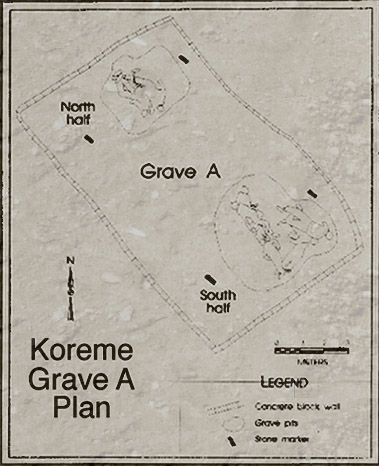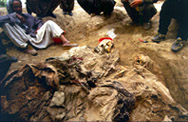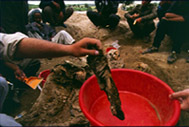
The men stacked
their rifles around the bushes and were forceful about getting into
the pits. They taught me how to direct their digging and the word "hedi-hedi"
(carefully, please) became the bulk of my daily vocabulary. The men
were stone faced about the bodies, but you could tell when a relative
was exposed. . .
Jim Briscoe
American Forensic Anthropologist
Whether or not all of the men and boys taken aside were
carrying weapons when they were captured - it is irrelevant to the legal
assessment of the crime that followed - survivor accounts are uniform
that these men were made to form a line.
A
lieutenant told them to sit down, and they did so, squatting on their
heels rather than sitting in the dirt. The other villagers, including
those men not singled out, were led away behind the hill near the partly
ruined village schoolhouse. Women and men screamed and cried out for
their loved ones as they were taken away and the soldiers an militiamen
tried to quiet them down....
|

Map of Koreme gravesite,
© 1992 Jim Briscoe

The
thirty-three detained men, too, wept and pleaded for their lives,
although the soldiers insisted that nothing would happen to them.
One of the lieutenants offered them cigarettes and water; meanwhile,
some twelve to fifteen soldiers had taken up positions facing the
line.... The soldiers opened fire at the line of thirty-three squatting
men from a distance of about 5-10 meters. It was not possible to
determine how long the firing went on or how many rounds were fired....The
forensic team, sweeping the whole execution site, recovered 124
cartridge cases, although these do not establish the total rounds
fired... |

Some
men were killed immediately by rifle fire. Others were wounded,
and a few were missed altogether. Remarkably, given the volume of
firing, there were six survivors....The soldiers left the execution
site, without burying the bodies or otherwise touching them, according
to survivors who lay among the corpses.
From:
Human Rights Watch, 1993, p. 46-47
Photographs 1992 ©Susan
Meiselas
|
|


